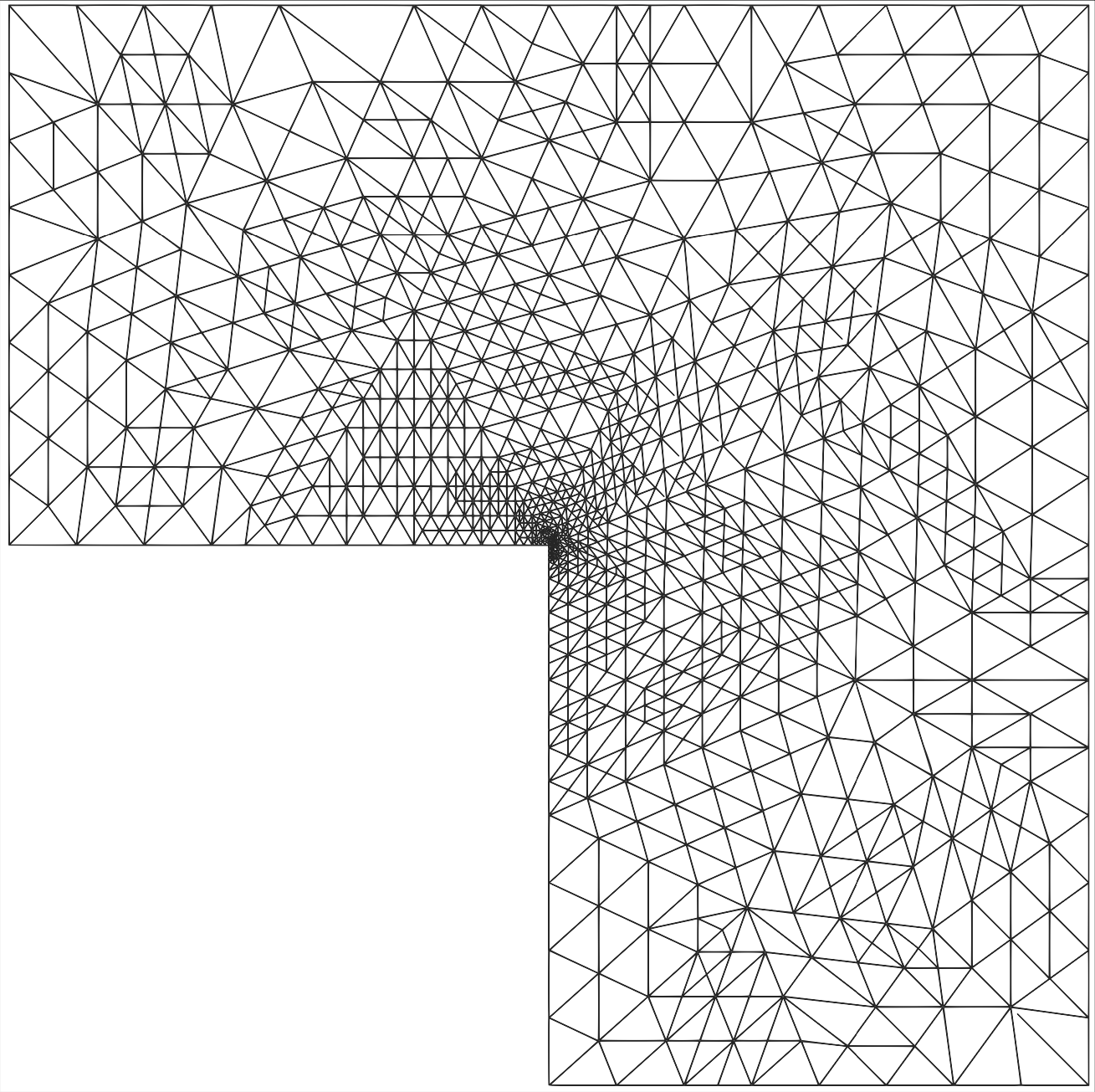FEniCSx-Error-Estimation
See all the details in the dedicated publication and the code repository.
What is FEniCSx-EE ?
FEniCSx-EE is an open source library for the finite element software FEniCSx. The goal of this library is to provide an implicit hierarchical a posteriori error estimation method. The method used in FEniCSx-EE has been introduced by R. E. Bank and A. Weiser in this research paper.
The Bank-Weiser estimator
The Bank-Weiser estimator is computed from local solves of Neumann boundary value problems at the level of the mesh cells.
This estimator has several advantages:
- It is fully local: its local contributions are based on solutions to Neumann boundary value problems restricted to each cells of the mesh.
- It can be adapted to many contexts such as diffusion, reaction-diffusion, convection-diffusion, linear elasticity, Stokes, fractional Laplacian equations.
- It is robust: with respect to the coefficient in singularly perturbed reaction-diffusion equations, to the coefficient in convection-dominated convection-diffusion equations and also to linear elasticity in the incompressible limit.
- It is flexible: it is possible to vary parameters in the definition of the estimator in order to find the most accurate one.
Details on our algorithm implemented in FEniCSx-EE and examples of applications can be found in the dedicated publication.
The derivation of the Bank-Weiser estimator
We consider the following standard Laplacian equation on a bounded domain with homogeneous Dirichlet boundary condition in weak formulation: we seek \(u \in H^1_0(\Omega)\) such that
\[\begin{equation} (\nabla u, \nabla v)_{L^2(\Omega)} = (f,v)_{L^2(\Omega)}\quad \forall v \in H^1_0(\Omega). \end{equation}\]Given a mesh \(\mathcal T\) on \(\Omega\) and an associated finite element space \(V \subset H^1_0(\Omega)\) the finite element discretization of \((14)\) reads: seek \(u_V \in V\) such that
\[\begin{equation} (\nabla u_V, \nabla v)_{L^2(\Omega)} = (f,v)_{L^2(\Omega)}\quad \forall v \in V. \end{equation}\]From \((14)\) and \((15)\) we can derive a local equation for the approximation discrepancy given by the function \(e := u - u_V\). If we denote \(T\) a cell of \(\mathcal T\), \(\partial T\) the set of edges of \(T\) and \(E\) the edges, the restriction \(e_T := e_{|T}\) is solution to the following local Neumann problem in weak formulation
\[\begin{equation} (\nabla e_T, \nabla v)_{L^2(T)} = (r_T,v)_{L^2(T)} + \frac{1}{2}\sum_{E \in \partial T} (J_E,v)_{L^2(E)}\quad \forall v \in H^1_0(\Omega), \end{equation}\]where \(r_T\) and \(J_E\) are computable functions depending on \(f_V\) (the \(L^2\) projection of \(f\) onto \(V\)) and \(u_V\) only.
The core idea of the Bank-Weiser error estimation is to pick a proper space \(V^{\mathrm{bw}}(T)\) to discretize \((16)\) and obtain a computable function \(e_T^{\mathrm{bw}}\), solution to
\[\begin{equation} (\nabla e_T^{\mathrm{bw}}, \nabla v)_{L^2(T)} = (r_T,v)_{L^2(T)} + \frac{1}{2}\sum_{E \in \partial T} (J_E,v)_{L^2(E)}\quad \forall v \in V^{\mathrm{bw}}(T). \end{equation}\]Note that, since these problems are fully independent from a cell \(T\) to another, they can be solved in parallel. Thus, for a given norm, the local finite element error is approached by the Bank-Weiser estimator defined as follow
\[\begin{equation} \|e_T\| \simeq \|e_T^{\mathrm{bw}}\| =: \eta_T^{\mathrm{bw}}. \end{equation}\]The quantity \(\eta_T^{\mathrm{bw}}\) can be used to perform adaptive refinement and to approach the global finite element error as follow
\[\begin{equation} \| e\|^2 \simeq \sum_{T \in \mathcal T} {\eta_T^{\mathrm{bw}}}^2. \end{equation}\]In here we develop a new parallel implementation of the Bank-Weiser a posteriori error estimator and we apply it to various problems such as adaptive refinement for standard Laplacian equations with different kinds of boundary conditions, for nearly-incompressible linear elasticity equations and for goal-oriented error estimation.


Above are two meshes adapted using the Bank-Weiser estimator. On the left is a standard Laplacian equation on a 2D L-shaped domain. On the right is the mesh of a femur bone on which nearly-incompressible linear elasticity equations are applied. The mesh on the right is adapted with respect to a quantity of interest centered in the middle part of the bone.

Above is the plot showing the strong scaling of our parallel implementation of the Bank-Weiser estimator.
Getting started
To download and get started with FEniCSx-EE, please follow the instructions from the README file on the github repository.
FEniCSx-EE is not currently compatible with the last stable version of FEniCSx. Maintaining FEniCSx-EE is not part of my current position but I try to update it when I find some time. 👷
